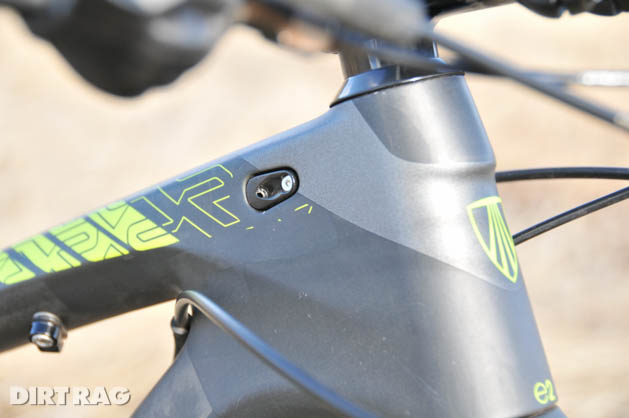Trail Tested: Trek Remedy 9.9 29
Originally posted on June 3, 2015 at 5:25 am
By Matt Kasprzyk
Amidst the 27.5 and fat bike boom Trek has been perfecting a 29er that redefines 140 mm travel, big-wheeled bikes. Sure, there’s a lot of proven Trek features that riders are familiar with, but the latest iteration of the Remedy is a mind-expanding ride experience because of two major design features: the Boost 148 rear hub and the new RE:aktiv rear shock.
Trek’s Boost 148 is a new rear hub standard, but before we start hating on evolution, let’s take a little time to at least humor why this makes sense. The rear hub spacing has been increased by 3 mm on each side. That might not seem like much, but it opened the door for Trek’s engineers to hit the quantitative numbers they were aiming for in terms of frame and wheel stiffness while allowing for contemporary design features like a PressFit BB shell with ISCG mounts, as well as the ability to fit larger chainrings while maintaining a proper chainline for 1x drives, without increasing Q-factor. But, maybe most importantly, this is not proprietary tech. Trek has left this as an open design. Soon we’ll see 148 offerings by companies like DT Swiss, Shimano and Industry-9—all of whom are already on board. Rumors abound that Trek’s 27.5 trail bikes will be using this standard in 2016 as well.

The wider hub increases 29er wheel stiffness by 15 percent, according to Trek, and goes a long way toward eliminating reservations about the lateral stiffness of a larger wheel diameter. The only question left is: When will we see wider front hubs for 29ers? It’s definitely coming soon, with recent confirmation of a 15×110 standard to supplant the current 15×100.
The other major story here is the RE:aktiv rear shock that was developed using technology from Penske Racing’s experience designing Formula 1 racing suspension. This regressively damped system uses a spring-loaded high-speed compression circuit that remains closed until enough pressure pushes it open. With the high-speed circuit closed, the firmly damped low-speed valve controls pedaling motions. Larger impacts open the high-speed circuit and the damping rate drops, allowing more travel to soak up sharp hits. On really big hits, the damping rate ramps back up to regain control of the travel.

Unlike Specialized’s Brain suspension that senses the direction of input, the RE:aktiv system is very sensitive to the velocity of impacts. Feedback from pedaling, or rider movements, is too slow to activate the valve. While pedaling it feels like a firmly damped and efficient climber, but as soon as you start descending at speed, the shock senses those fast impacts and fully opens up with a quick and seamless transition. The rougher the terrain the quicker it reacts, but there is never a noticeable transition or perceivable delay back and forth. The CTD settings change the preload on the RE:aktiv piston. Regardless of preload settings, when opened the valve works the same, so you get the seamless changes in damping in all three modes, but a higher amount of force is needed to activate the high speed circuit in Trail or Climb.
What does all this axle width and car-racing tech feel like on the trails? Well, it’s tough going back to a bike that doesn’t use this shock.
The Remedy seems to float over rough terrain. It skips through the rough and rounds the tops off protruding rocks. The rear wheel always seems in contact with the ground, and I felt in total control of the rear end of the bike. It felt completely balanced, where the back end was working in tandem with the front suspension. The 140 mm travel RockShox Pike was perfectly paired with the RE:aktiv performance.

Trek spent a lot of time collecting quantitative data before any prototype was drafted. On paper the geometry isn’t revolutionary, but combined with an incredible suspension system and the stiffest aluminum wheels that I’ve used, the resulting impression is that this bike is hands down the best long travel 29er I’ve ridden. The fact that Trek’s enduro team often races on the Remedy when the longer-travel Slash is an option goes a long way toward explaining just how capable this bike is.
Control at speed through rough sections is noticeably better than many longer-travel bikes out there. In addition to how much fun it is going down, it climbs very well and there isn’t any fiddling with knobs when you get to the top. A lot of bikes pedal well or descend great, but what’s remarkable is how nicely the new Remedy switches between pedaling efficiency and absolutely murdering descents without the need to adjust its CTD settings.
Trek’s Mino Link allows you to adjust the head tube angle by half a degree (68.2 or 67.5) and change the BB height by up to 10 mm, but that feature is set-and-forget for me. After trying the slacker setting, I found the Goldilocks numbers that agreed with me during all of my trail riding. The bike fit well, providing immediate confidence while riding and leaving me with zero desire to change any of the stock components, which consisted of a SRAM XX1 drivetrain and Shimano’s potent XTR Trail brakes. At 26.1 pounds without pedals it’s also one of the lightest in its category.
If this bike asked me to get on a plane to Trektown in a South American jungle, I’d grab that Kool-Aid and say, “All aboard!” Sign me up for the next two-wheeled religious experience. This is a must-ride, and I’d recommend any of the carbon or aluminum models with the RE:aktiv shock to just about anyone who is shopping for one of the best trail bikes out there.
